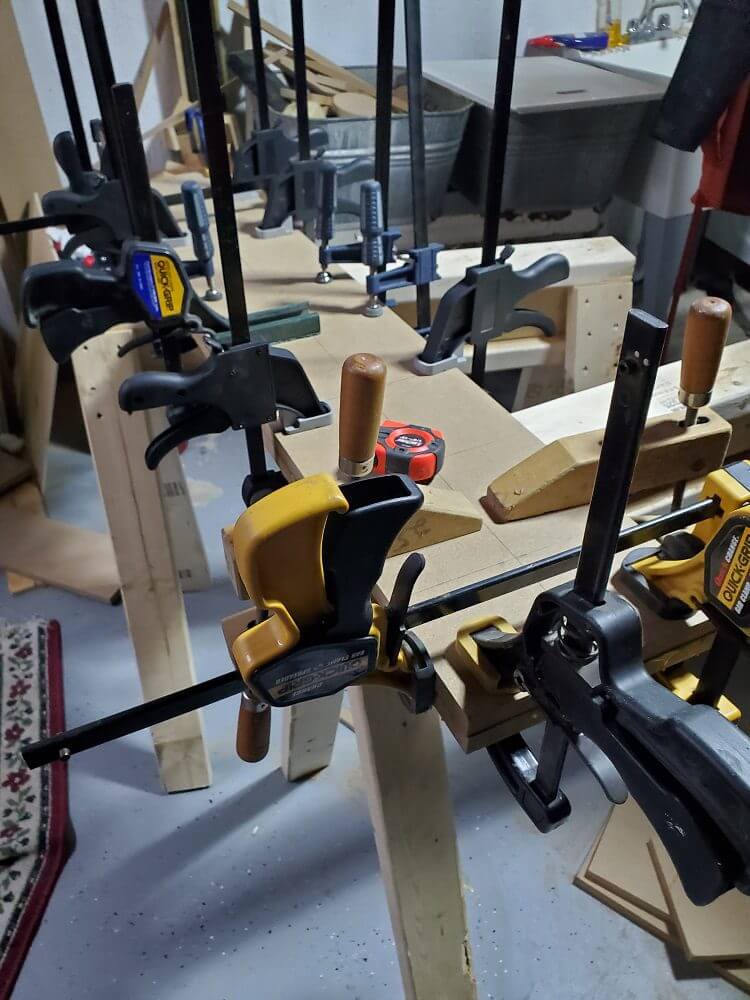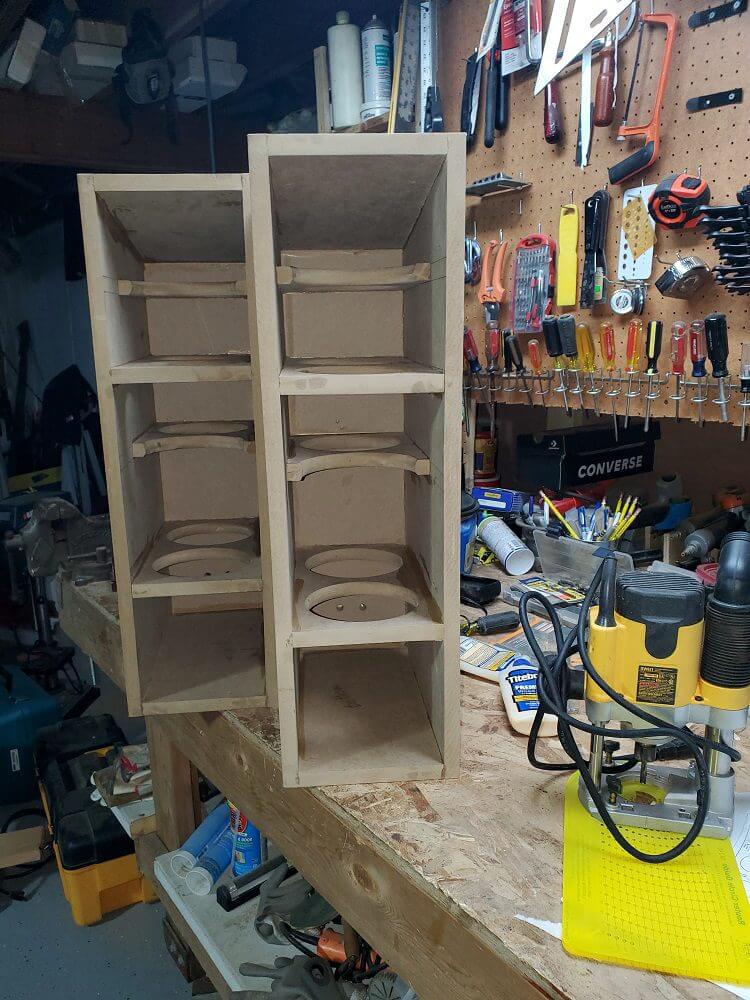If you want the most bang for your buck and you are decent with power tools and also willing to invest the time you can build an amazing set of speakers. As it can be a very rewarding experience. I am currently in the middle of a speaker build and I wanted to share my experience with readers on my website because it is a great way to save money and get amazing sound.
My current main speakers (Boston Acoustics T830) are just not cutting it anymore as they are alright but do nothing to blow me away. I want to be blown away by detail, sound stage, and imaging, and to get lost in the music. The biggest way to improve the sound is to get better speakers. Right?
Maybe you should build your next set of speakers too…or at least let it bounce around in your head for a while and see if you are up to the challenge.
The Kit I Am Building Currently & Why I Choose It
The speaker kit I decided to embark on the building is the GR Research X-Statik Kit. This kit starts out at $749.00 and upwards to $1,057.00. There are additional parts & costs too, like the flat pack or buying the MDF and doing it yourself (the plans are on the GR website), additional tools you need to buy, and No Rez. Danny highly recommends using the No Rez which is a damping material that goes inside the speaker to reduce resonance.
One of the benefits is you are able to spend more money on quality parts and materials as opposed to paying mark-ups through middlemen and companies’ profit margins by just doing the work yourself.

Why The X-Statik?
This is around the price I was looking at spending for a set of speakers. Additionally, I would have to spend twice as much to get the same kind of performance as this speaker, at least from what I have read and heard as I haven’t heard them. I did do my research and l researched as much as I could on these speakers and I think I was really won over by the reviews as well as the quality of components.
People that own this speaker rave about it. Plus I know that all the electronic parts are quality. This is a partially open baffled speaker as there are two woofers for the mid-range (open baffled) and two woofers for the low range (sealed) with a domed tweeter in the middle. These speakers need to be at least 3 feet from the wall and I have room for that, as open baffled speakers need space to sound good.
I don’t mind spending my time putting it together, but if you are wondering it does take a considerable amount of time to finish to save money. I don’t have unlimited funds to spend on speakers but I do want to get the most out of my dollars and I think the DIY speaker build is where I will accomplish that.
GR Research has a full price range of DIY speakers to choose from, from the Desktop “Mini” to the NX-Treme. I appreciate the owner of GR Research’s openness and the amount I have learned about speakers in general.
Quality Quality Quality
It is quite surprising to have the veil lifted that most speakers have substandard parts. Some of the biggest speakers brands that sell for hundreds of dollars to thousands of dollars often use the cheapest electronic components for the crossovers parts. This just blew me away. Danny’s videos show the parts used in the crossovers and where improvement can be gained by replacing those parts.
Everything matters when building a speaker.
The veil was lifted for me after watching a video from Ron on the YouTube channel New Record Day where he introduced me to Danny Richie owner of GR Research. Danny’s website sells speaker upgrades, speaker modifications, DIY speaker kits, DIY subwoofer kits, flatpacks, completed speakers, cables, drivers, and accessories. Danny also has videos on his own YouTube channel (GR-Research) where he freely shares his vast knowledge, and also test speakers.
The quality of the components makes a huge difference in the performance of a set of speakers. A little-known secret is most companies skimp out on these components. You don’t really know until you look inside. I took a peek into my old speakers the Boston Acoustics T830 after I had to replace the surrounds earlier this year and let’s just say I saw a lot of cheap components. No wonder I was never really blown away by them.
Pros & Cons
Pros
- A very rewarding experience.
- Learn new things. Soldering, woodworking, speaker building and design, and problem-solving skills. It is just continuous as you just keep learning about things I have never thought of doing. But one thing is for sure I have learned a lot.
- Save money by doing the work yourself, cutting out the middleman, and getting higher-quality parts.
- It’s fun and interesting.
- The Forum on the GR Research page is a good place to research and also ask for help. Many people post pictures of their builds and answer questions.
Cons
- You need a bunch of power tools and hand tools, if you don’t have them it can be expensive to purchase the tools you need.
- You have to factor your time into the equation as well. Depending on the project will take a considerable amount of time from start to finish.
- Can be difficult as you are often left kind of on your own to figure things out.
- I had to buy quite a few tools which adds to the total cost of the project.
- You make mistakes along the way but this is where you learn the most.

Tools I Needed To Buy
I have a bunch of woodworking tools but I still had to purchase additional tools to work on this project. I also have quite a lot of work experience working with wood products, as I have worked as a roofer in a door factory for many years. I spent close to $300.00 dollars additionally on tools and probably going to be at least a hundred more as I haven’t bought my veneer yet or stain.
Luckily I own a router and a table saw and didn’t need to purchase them. Tools are expensive and really add to the overall cost of the speaker build. The money for tools needs to be factored into the overall cost of the build.
- Jasper Circle Jig Model 240
- SpecTool Spiral Router Bit Upcut 1/4 inch Shank 3 inch
- Freud 3/8″ Radius Rounding Over Bit 1/4″ Shank
- Freud 3/4″ Radius Rounding Over Bit 1/2″ Shank
- Spiral Flush-Trim Router Bit 1/4″ Shank Down-Cut
- Makita 5007Mg Magnesium 7 1/4-Inch Circular Saw
- Freud Diablo 7 1/4″ x 60-Tooth Ultra Fine Finishing Blade
- Clamps – You never have enough of these I purchased these at Harbor Freight as these are the cheapest I have found.

The Last Groove
If you have some basic woodworking skills as well as tools for building a set of speakers it might be the more affordable route instead of just purchasing a speaker set outright. This is up to you to determine for yourself. There are many different DIY speakers builds out there, ranging greatly in price. Some products are simple others very complex.
Do your research into how they sound and think about what tools you will need before purchasing any kit. Search for videos as well as have some sort of resource (friends, forums, videos, websites) to fall back on to ask for advice when you have questions.
In the process of building these speakers, I have really learned a lot and I am only halfway through the process. I find this knowledge invaluable going forward deeper down into the audiophile world. Hopefully, when I am finally done with these speakers I don’t have to worry about upgrading for decades. I will post some pictures when I am done with the finished product.








Recent Comments